This is the third installment of an ongoing weekly series. Objects #1 featured a mini-Christmas tree, used tea bags, and a very rare (or possibly extinct) bird. Objects #2 featured red Converse, White Claw, and a roll of paper towels named Dolores.
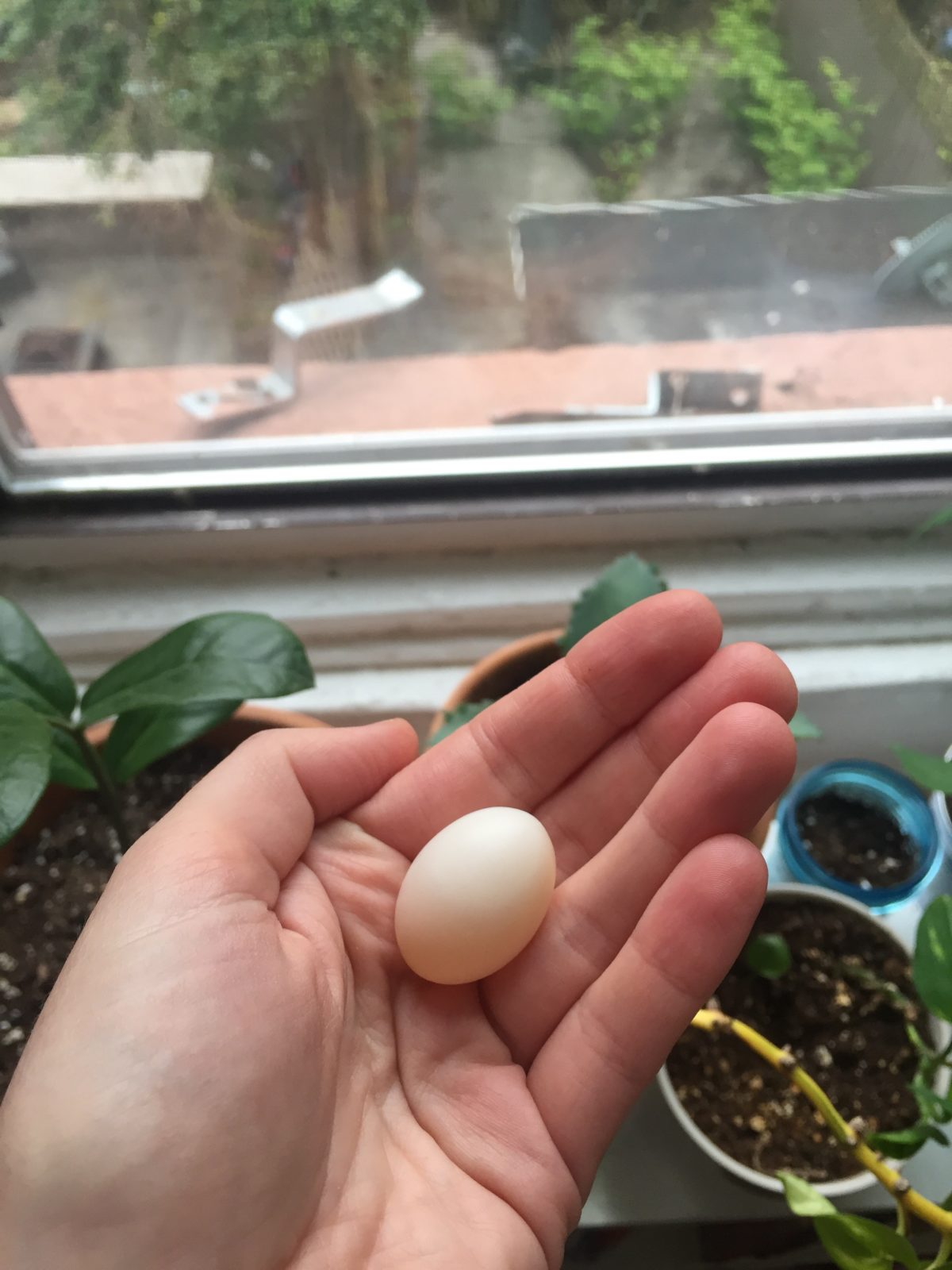
VII. Should We Euthanize the Egg?
Observer: Moira Donegan, on April 25, 2020, in Brooklyn, NY
Object: Mourning Dove Egg
Level of Affection: Deeply Reciprocal
Before we started, Moira explained she was a little out of breath; she had just been doing a 1982 Jane Fonda workout video at home because “all the gyms are closed.”
I live in Brooklyn, and because I am so bored and lonely, I started buying peanuts and rice cakes that I would crumble up and leave on my windowsills for birds. Somebody told me that if you leave peanuts in shells out for crows, they will become your friends and bring you presents. OK, so I’m like, Maybe if I can’t see my human friends, maybe I can make friends with some crows. I don’t have a bird feeder, so I’ve just been leaving them on my windowsill. And I went to put more peanuts out on the windowsill, and I saw that on the sill next to it, there was just an egg. At first I thought maybe it was a crystal. It looked like something you would buy—it would be in a square, clear plastic case at, like, the Sharper Image for ten cents each.
And I thought, What is this? And I realized it was an egg and there was no bird to be seen. There’s no nest. So we took it inside and we put it in a Keds shoebox. I have a little blue Keds shoebox that says “Ladies First.” My girlfriend owns a heated blanket, and we put that inside the box to construct this little makeshift incubator.
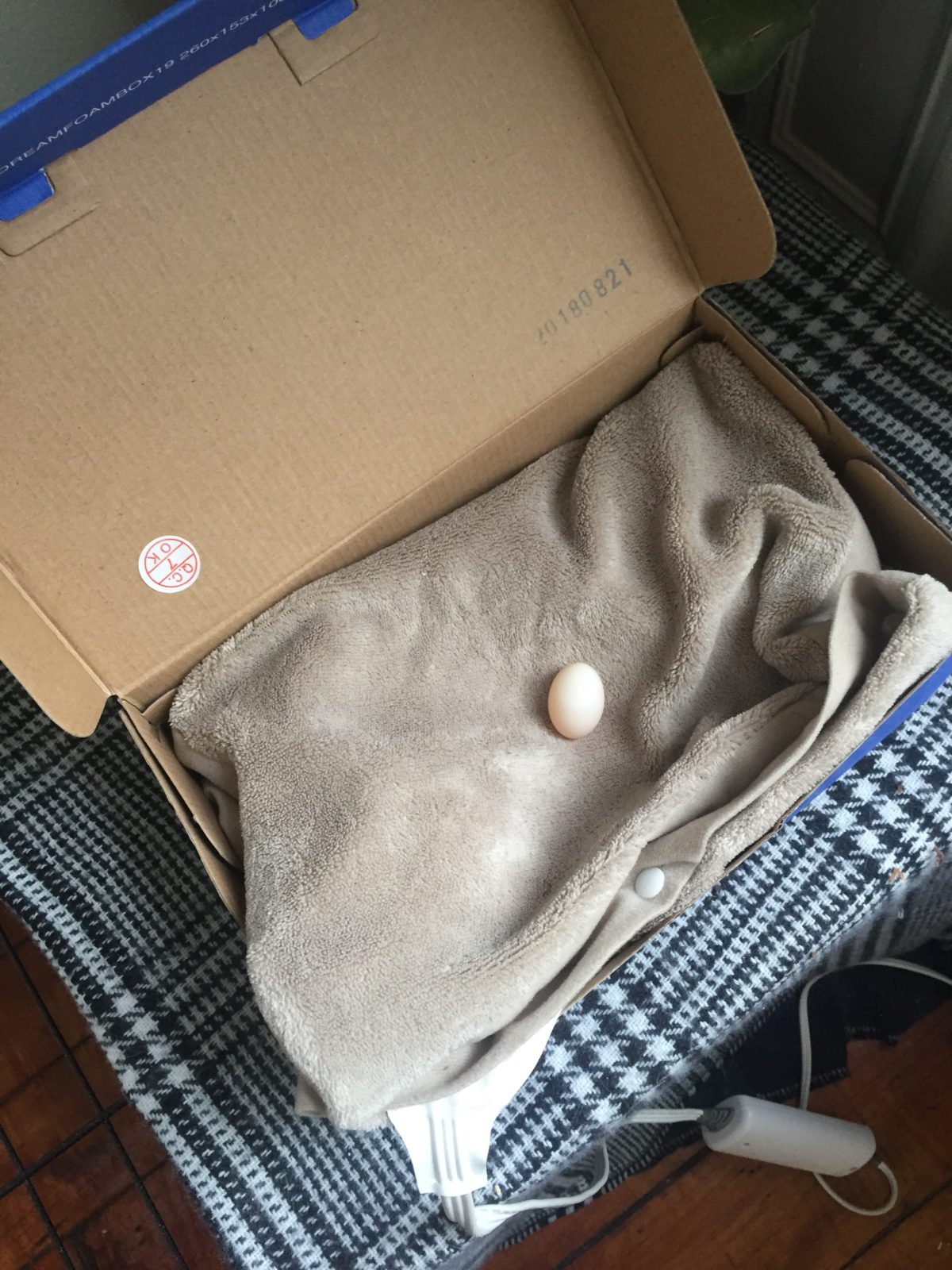
And we put the egg in there and we were sort of freaking out. We were like, “What do we do with it?” This was also, like, the most entertainment we’ve had in weeks. This is two, three weeks into quarantine. We googled around and realized that it was a mourning dove egg, which makes sense because there are mourning doves in the area and they’ve landed on that windowsill before.
Also, apparently, mourning doves are very, very bad at building nests. They’ll build a nest and then it will fall apart and they’ll keep trying with the same bad materials in the ill-advised location to build a nest over and over again, and it will continuously fall apart and they can go on the whole mating season like this.
Either the egg fell out of a nest, or a desperate female dove needed to lay her egg and had no nest in which to do so. So this orphaned egg came into our house. We called the Wild Bird Fund, which is this amazing group on the Upper West Side. It rescues all kinds of birds out of a storefront. And they never got back to us. I think they are on limited operations right now because of what’s going on.
The internet said if you keep it at a hundred degrees or so, it should develop. And for a while we had this thing in a shoe box and we went to check on it, you know, kept the heat up and checked on it a couple of times a day, just holding our cell-phone flashlights up to the egg and we could see it—you could see something changing in there. It went from being totally translucent to having these clouds and then a vein grew and there was a shadow.
So we were like gonna have a bird, man! And that’s when we’re like, “Oh no!”
’Cause I think we sort of didn’t expect it to work. We were like, “Oh, this will be a fun science experiment that will fail and, you know, expire at around the same time as its entertainment value.” And then it became clear that this tiny little life was actually gonna maybe come. And we had a lot of, like, soul-searching.
So I googled around and it turns out that when you have a baby dove, you need to feed it something called pigeon milk. It is fed something that is like the lining of its mother’s stomach that gets regurgitated and then put into the mouth of the baby birds. And you can buy this synthetic, and it’s not very expensive. And then I found out that you need to feed them every fifteen minutes. One five.
I was like, OK, well, that’s often. And then I found out that hand-reared baby birds, like baby birds that are raised by humans, can almost never enter the wild. You can’t release them if you hatch some yourself, ’cause they don’t know how to be a bird—they don’t know how to fly on their own really. They don’t know how to find food. They don’t know how to build shelter. There’s all this education and socialization that happens in this whole other dialect and language and set of references for the world that you cannot impart onto your, uh, bird child. Like, it’s living in a different world than you are. So we were wondering whether we should euthanize the egg, whether that was like the correct thing to do, and I sort of couldn’t bring myself to do it. Because I had grown very sentimentally attached to this little thing. It’s about the size of like a half dollar. It’s like a little bigger than a quarter, I would say. It fits in my palm. I will send you a picture. And there’s so much uncertainty about our future and I think we wanted to be optimistic about this tiny little creature.
And then the more information we got, the less optimism seemed reasonable, you know? I want to say we found it early in April. And so we were told that it would incubate for about three weeks and then hatch. And if it hadn’t hatched in three weeks, then we could presume that the egg had failed to thrive.
We’ve been looking at it with our cell phones. It seems to have stopped developing. I don’t know if maybe it sensed our apprehension about its arrival, or if maybe, you know, our janky homemade shoebox incubator just wasn’t up to the task. But we gave this little guy our best, even though we were afraid of the world that it was coming into.
We’ve still got the incubator on, just in case, but the 27th is supposed to be its last day. And when that happens, I don’t know what we’ll do. Maybe we’ll leave it outside. Maybe we’ll give it a funeral in the backyard. I’m not sure. I’m sorry. This is probably darker than you thought it was gonna be.
Here I asked if she’s ever done anything like this before.
I mean, we hatched chicken eggs in kindergarten as a school project. Kat has really wanted to raise chickens. You know when you’re like, examining the life you would have had if the pandemic hadn’t crashed the economy? One of the things we were thinking about doing was moving upstate where I could have a garden and she could have chickens.
And I think we were acting out in symbolic and miniature ways, a future that we’re afraid we’re not going to get any more, through the egg. And the egg’s death or the egg’s failure to turn into a bird has become maybe a greater symbol of the way we have to reevaluate our futures. It’s a little on the nose that it’s a mourning dove, too, like, M-O-U-R-N. Like, Jesus Christ. I feel like if it was in fiction, I would tell somebody to cut it. You know?
My level of affection was utter delight and marvel and wonder. I never would have noticed that thing on the windowsill if I hadn’t been trapped at home and paying all this attention to the birds of my neighborhood, you know, like wild birds of Bed-Stuy, and like, trying to cultivate the friendship and affection of these things that I would ordinarily overlook. So, on the one hand, I feel really honored and delighted to have been given this gift and the chance to watch this thing inside there, um, change. It’s like this weird, gross miracle. And you know, it gets veiny and disgusting—that was really fucking cool.
And on the other hand, nine times out of ten, probably this egg wouldn’t have lived anyway, pandemic or no pandemic, because nature is red in tooth and claw, etc., and mourning doves can’t build a house for shit—there’s all kinds of other inadequacies beyond those of, like, the economy or my personal character, that probably doomed this thing. But I also feel kind of guilty and mournful about it. I, like, want to tell it that I’m sorry.
This was not on my radar for the apocalypse at all. Everyone is super vulnerable. Everything is a metaphor. You know, it’s like you can’t have anything light in the pandemic. Everything has Meaning, you know, capital M. I think it’s definitely a time where, for all sorts of reasons, we’re all compelled to reflect more on our responsibilities, and our actions all have more gravity. It’s forced me to grow up a lot, I think is what I’m trying to say. It’s made me more conscious of the vulnerabilities of others and of the ways that I can impact them. And that extends to elderly people in my neighborhood and also this little egg.
You know, I’m really taking seriously what to do with it when it’s no longer viable, which would be on the 27th, which is in just a couple days. I’ve thought about just tossing it. I’ve thought about maybe leaving it outside for other birds. Some other birds will eat the egg, that way it could like go back into, you know, the circle. Or maybe I’ll do something more solemn with it. But I do want to bring to a close this experiment in a more meaningful way that reflects all the metaphor I put onto this poor little egg.
It’sa deeply reciprocal relationship I have with this little inert, uh, like, bulb on a heating pad in a corner of my bedroom.
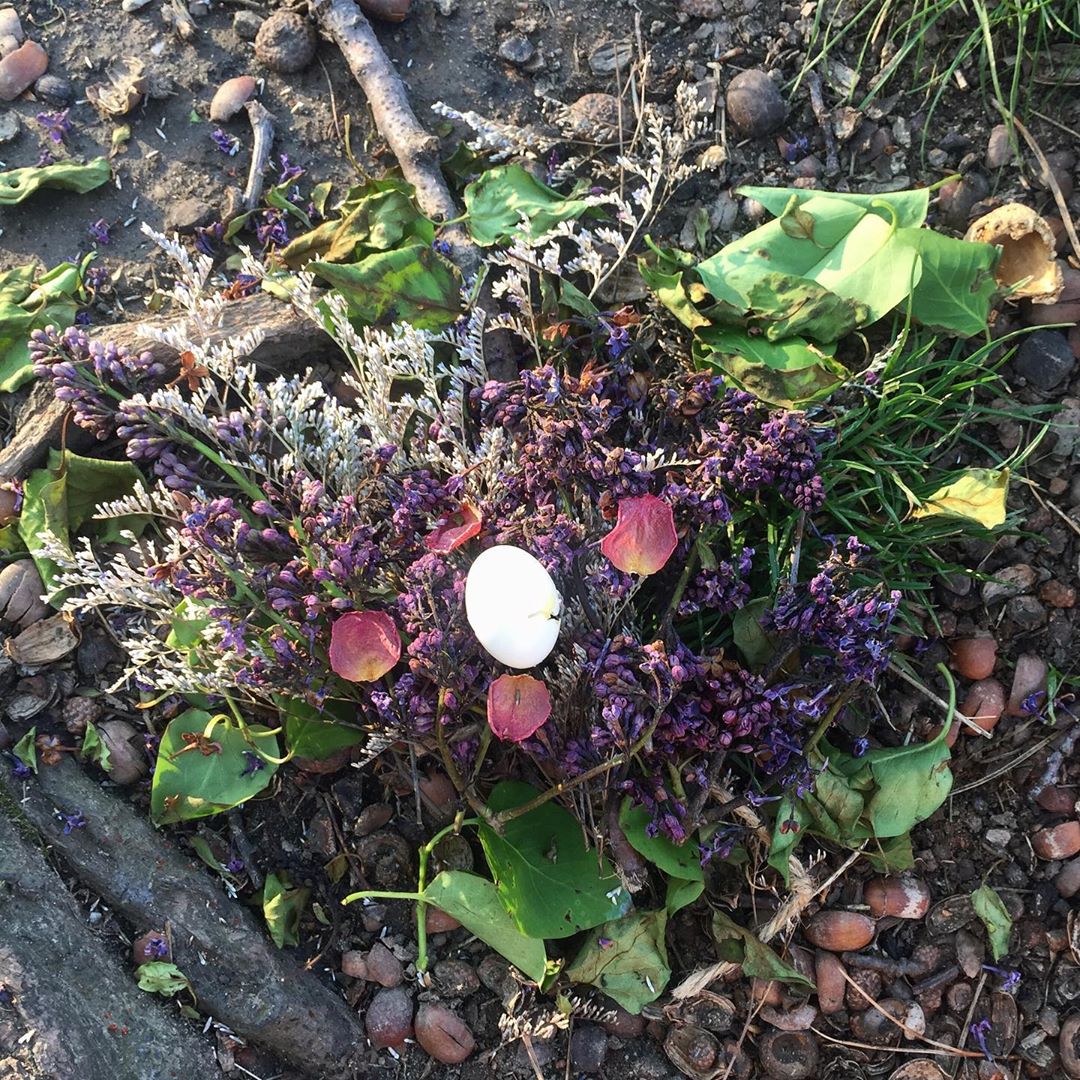
A week after our call, I saw on Moira’s Instagram an image of the egg on a funereal bed of lilacs, baby’s breath, and rose petals in the park. The caption read “RIP,” followed by the egg emoji.
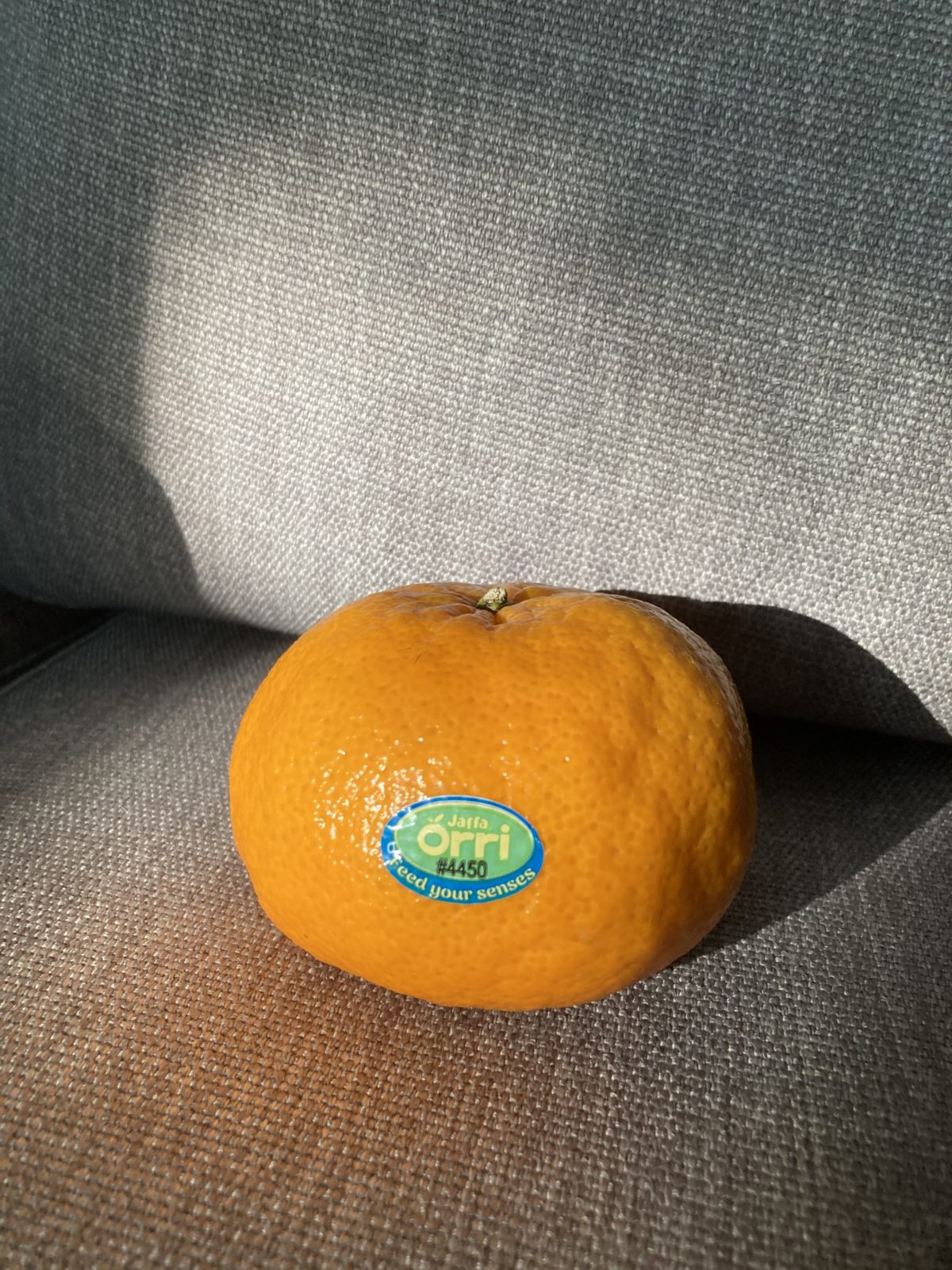
VIII. Every Time I Eat It Is the First Time I Eat It
Observer: Tracy Wan on May 11, 2020, in Toronto, Canada
Object: Orri mandarin orange
Level of affection: Like a wondrous alien or a gem
I do this thing called an “Exotic Fruit Report,” where I go chasing fruit in various cities that I travel to. Fruit has always been part of my objects of obsession. But lately I’ve started looking at the quotidian fruits of my life in a new light, maybe because of access and the necessary reframe that we’ve all had to do in our lives with respect to our habits and our routines and our consumption.
There’s a fruit market up the street that I do most of my groceries at because I can’t stomach the idea of lining up for an hour and a half to go into a grocery store. I’m in Toronto and the two major grocery stores near my house, every time I’ve tried to go—which is three or four times in the last two months—they’ve been lined up out the door and around the corner. So instead, I’m trying to support produce suppliers who are now doing door-to-door deliveries or my local immigrant-run green grocer.
Before, when everything was readily accessible, I was more in the mindset of, like, chasing novelty. I didn’t really pay the closest attention to how delicious some of these everyday fruits in my life can be. And since I’ve begun restricting what I buy and what I consume and how often I go out and purchase it, I’ve had more time to focus and appreciate the things that I do have.
Oranges have the particular quality of bringing joy and levity to your life, like you don’t even sometimes notice it. Um, have you heard of shower oranges? It’s this practice that certain people on Reddit started doing where they take a shower with an orange and, in the shower, eat it. And it has this really amazing sort of alchemy, because when you shower with an orange, obviously the mist and the humidity accentuates and multiplies the aromatherapy quality of the orange. The zest and the peel become really intense. It feels like this extreme ritual of luxury that is readily available to almost everyone, which I find very exciting. I love hacking my life in a way that it feels like a small luxury, even though it’s absolutely not. I haven’t actually had a shower with these particular Orri oranges, but I imagine it would be amazing. You can do this with any orange.
Three or four weeks into quarantine, I bought a series of these and out of a desire to ration myself, I was like, OK, I’m going to have like one a day, not more than one. And so when I decided to put this into practice, the first one that I grabbed—my orange for the day—I peeled it and took a bite and I was like, “This is the most incredible thing I’ve ever eaten in my life.” And I ushered my boyfriend over and I was like, “Will you just taste this orange?” And I sort of fed him one and he was like, “Oh wow. I don’t think I’ve ever truly tasted an orange like this.” I don’t know if he meant that particular orange was unique, or the experience of tasting an orange was unique. I feel like some things are probably better left mysterious.
So, as of that day, it became a thing for us where we’d be like, “It’s orange time.” And I would carefully separate one orange into equal halves and then leave him with his half and then slowly savor my half, quarter by quarter. It became a real ritual. I’m still blown away by it. It’s like every time I eat it is the first time I eat it.
There’s also this immense sense of gratitude that I’m able to experience something that, you know, the forces of globalization have enabled. In this town in Canada, I’m able to get access to an orange from Israel, which according to my research is where these particular mandarins are from. I imagine this isn’t the case in smaller towns or remote places. Every time I have one of these oranges, it’s also a reminder of that privilege. Even the idea of having what is essentially an ornamental orange.
I asked if she ever finds herself talking to the oranges.
I haven’t entered into a conversation with the orange yet, mostly because I feel like I regard it with wonder, in that I can’t believe it exists. Sometimes I feel like my relationship to it is more like that of meeting an alien, or discovering something that I didn’t know existed before. Really, it strikes me as a jewel or a gem. I almost want to hold it up to the light and look at it, just to see all of its facets.
I’m really tasting it. I’m smelling it. I’m tearing through a peel into tiny little bits to optimize the essential-oil exposure.
I asked her about Exotic Fruit Report.
Exotic Fruit Report is the thing that I’ve intermittently done whenever I travel to a new city and discover a new fruit. I will buy it, try it, document it, do a bit of research about it, and then write up a little blurb for my Instagram. I’ve been doing this for probably five years. The hunt and the novelty and sheer miracle that these things exist and are available to be sampled, I think, was what drew me to it. For example, last year I went to Mexico City and tried a bunch of fruits there, and Mexico has an extraordinary assortment of exotic fruit—not so exotic to them, I’m sure. But in Toronto, where barely anything grows, it was very exciting.
But now, because obviously no one’s traveling and I’m not going to any particular fruit vendors in the city that would import more rare fruits, I’ve had to carry over this obsession with fruit onto the everyday. I had a Honeycrisp the other day, and it was a revelation. I don’t know if it’s just every experience is given the room to shine—because now everything that we do that’s not just, like, spinning in circles in our apartments… is kind of novel.
I’ve been thinking a lot, too, about where we find meaning in the current situation. I’m really looking forward to a world where people just appreciate the little things, and social contact isn’t taken for granted, and all of these new discoveries about ourselves—we’re going to emerge with on the other side with those. Hopefully.
I would recommend everyone takes a shower with an orange. Just to try it. The antidepressant effect is very real, and I feel like most of us can use that at least once, while we’re at home.
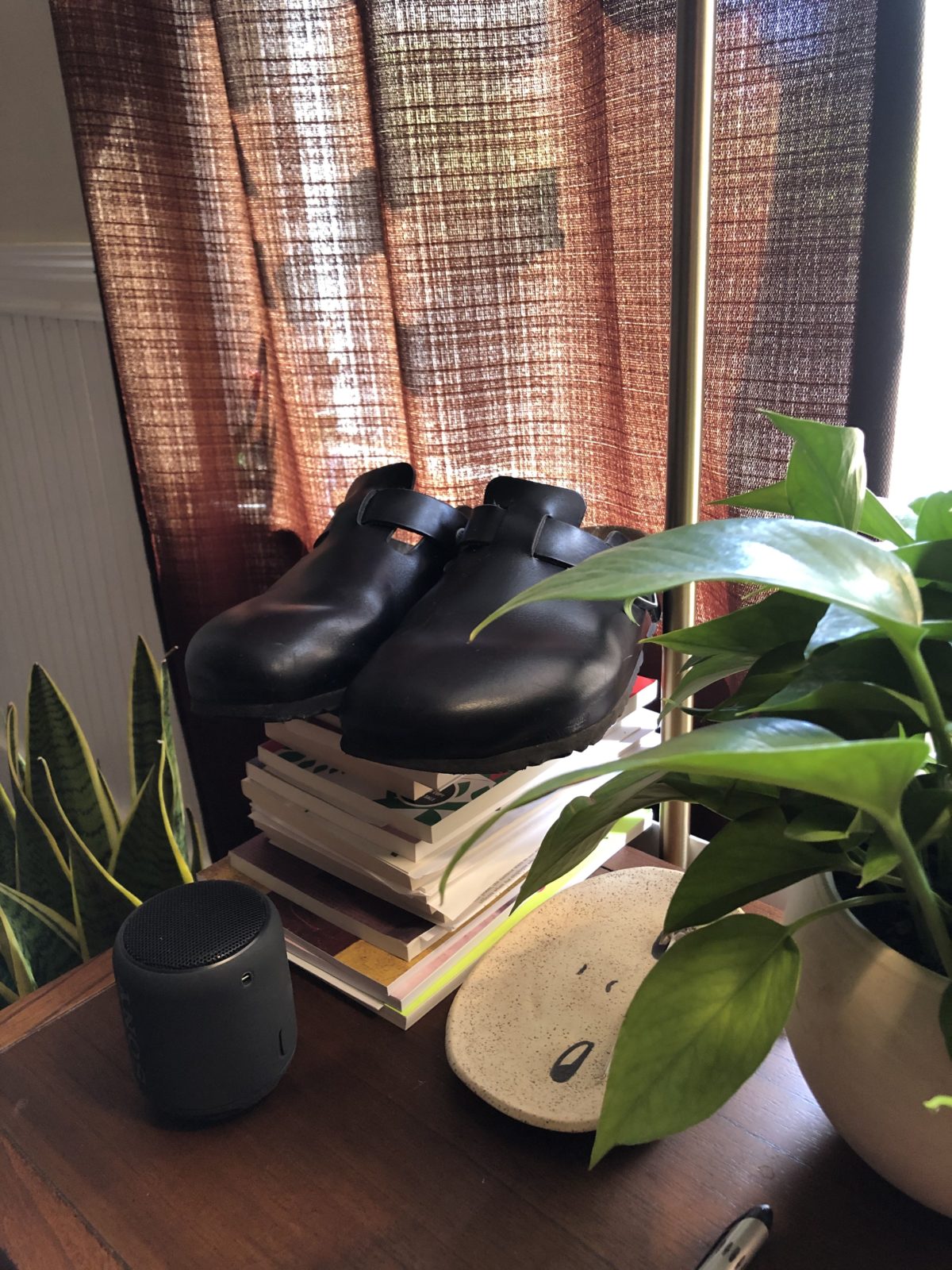
XI. They’re Like, “What Are Those?”
Observer: Ismail Muhammad on May 7, 2020, in Oakland, CA
Object: Birkenstock Bostons
Level of Affection: Invested
As we spoke, Ismail walked in his Birkenstocks to a cupcake shop in North Oakland, one of his quarantine routines.
I get out of bed, and they’re at my bedside. I put them on and I just go. They’re this weird combination between slippers and clog and sandal, so it’s all-purpose. They’re kind of wedded to my feet at this point. I was telling a friend, I have only had five days in the last two months where I haven’t been wearing my Birkenstocks.
I resisted getting them because they’re a common sight around Oakland and Berkeley, especially. Everybody is wearing Birkenstocks or Tevas or Crocs or Uggs. I don’t know, the Bay is really into the ugly shoe. It’s not ironic. It’s not a fashion thing. It’s the way things work here. I’m more used to wearing sneakers or boots. When I first moved here, I was like, “What are people wearing on their feet?”
There’s this shoe store down the street from the UC Berkeley campus on Telegraph. And because I have to drive from Oakland to Berkeley to teach on campus, I end up walking by the shoe store all the time and they just have an array of Birkenstocks in their window. After like seven years of walking to and from campus from my car, I kept seeing these Birkenstocks, and they wore me down. And last summer, I was just like, “Let me go buy a pair of Birkenstocks and see what all the fuss is about.”
I didn’t get the normal ones. When I walked in, I saw these. I bought the Bostons. You can slip in and out of them. They’re very easy and comfortable. They felt not as ugly as other Birkenstocks. Although, in actuality, they are probably uglier. They have the open heel, but then there’s this massive, bulbous toe. It’s… quite a sight.
Honestly, there’s something really alluring about the line. I was like, “Whoa, what are these?” After a while, they just really grew on me. Something about the shape was beautiful.
I’ve been here for almost a decade now, which is alarming to me to think about. When I first moved here, I thought I would do five years of grad school, then like move back to LA or to New York or something. But I have really come to love being in the Bay. I’m not sure that I will ever leave. That transition happened around last summer. I felt like buying the Birkenstocks was my succumbing to being a Bay Area–lifer.
I asked Ismail what color he got.
They’re black. It’s sleeker. They don’t make the shoe any more loud than it already is. One of my friends, he copied me. All my friends, like, hounded me after I bought them. They were like, “Ismail, what are you doing? What are those?” But after a while, one of my other friends got a pair. But he got the white ones, which are so loud. It’s like when he walks around in them, you don’t see anything else he’s wearing, you just see the shoe.
It’s funny. It’s not like I would call them pretty, or cool or anything. I wear them everyday. I was wearing them pretty often before the quarantine happened. Not when I was teaching, but any other day, I might just slide them on and go about my day. But now I have a quarantine uniform, which is a pair of Nike joggers and a white T and the Birkenstocks. Just whatever is easy and comforting.
A blast of distorted music, from one of the “eight or more” Baptist churches nearby, came through the phone.
Sorry, let me get off the main street. There’s a lot more cars on the road than there were in previous weeks. You can see the uptick and regular activity now, which is kind of alarming. But the Birkenstocks feel like a source of consistency. A comfort, because I am walking up to three hours every day. They don’t do a number on my feet the way that my stylish but impractical Nikes do.
I’m not a sneakerhead or anything. It’s, like, an extra thing to deal with in your life. But with these, I found myself cleaning them more often, treating the leather and treating the cork, like once a week at this point, which I’ve never really done with shoes before. It’s such a nice thing to sit down with them and clean them and use the cork sealer on the shoe. It’s a thing that I can take care of. Kind of like I can do with my plants. I have potted plants in my room for the first time.
But the Birkenstocks, I have invested something in their care, which is new for me. I wonder if I will keep up after the quarantine, after I have other things to direct my attention to. When they were sold to me, the salesman was like, “All right now, you have to buy cork sealer and take care of the cork or else it will get brittle.” It’s like he was initiating me into this new responsibility to take care of this shoe. I was thinking, All right, man. I’m not gonna do that. Now I find myself following his directions.
It goes back to what you were saying about controlling what you can control. I find myself directing a lot more of my attention to what I eat. I’m cooking more often and more elaborately. Like, taking care of my space, taking the time to direct attention to how my space is arranged and what it looks like, how it makes me feel. I’ve been running for the first time in four years. I can’t stand running, but now I have all this time on my hands, so I’ve taken up running. We’ll see if that sticks. And the Birkenstocks are a part of that, just finding things in my life that I can put order to, arrange to my liking, and care for.
Same thing with my friends too. This upsurge in attention and care. I know gratefulness is a weird idea for the times we’re living through. But it has made me feel grateful for my relative security and the help of my friends and family. And for the presence of things that make me happy at a time where I generally feel disoriented. It really makes you realize that you have to cultivate joy, however you can get it.
*
Do you have a newly significant object you’d like to speak to me about? If so, please email james[at]believermag.com with the subject line “Objects of Affection.” Briefly describe what the object is and how you would characterize your pandemic-era relationship to it. I will read through all responses and contact you for a short interview should the object suit the series. We will be publishing these weekly through May, and possibly longer.
*
Moira Donegan is an opinion columnist at The Guardian US.
Tracy Wan is a writer and scent advocate living in Toronto. Her work has appeared in FASHION, Hazlitt, BuzzFeed, The Hairpin, and other places.
Ismail Muhammad is The Believer’s criticism editor.
*
For more installments of this series, go here.




